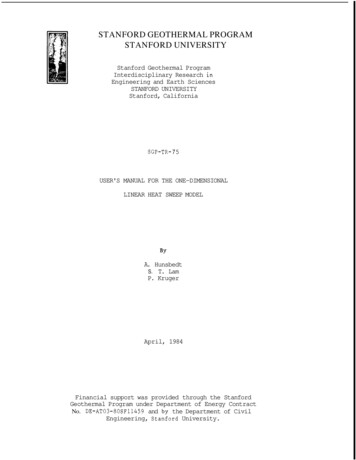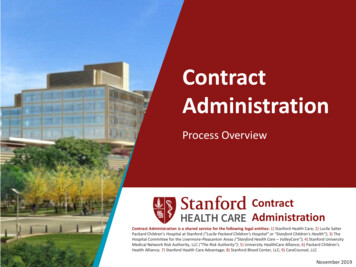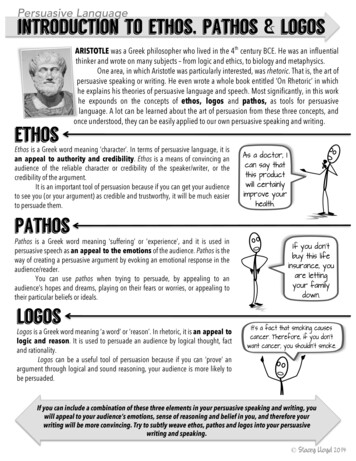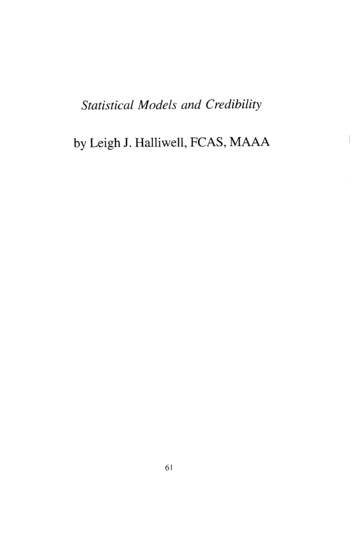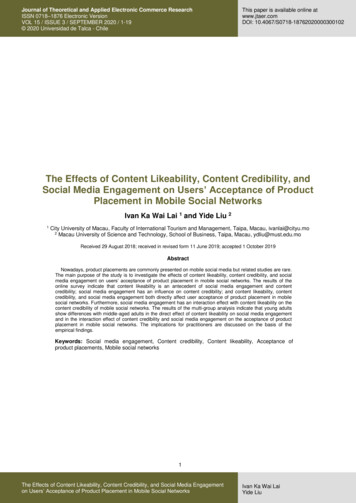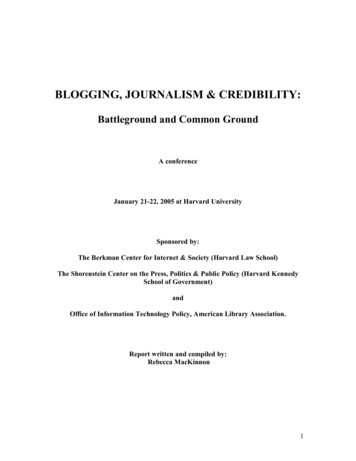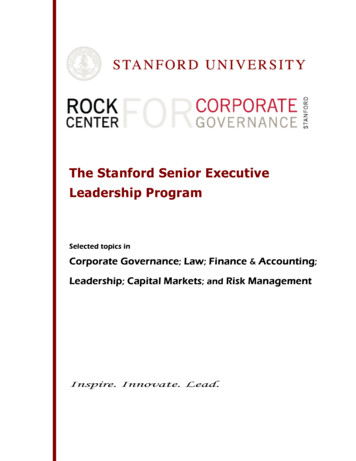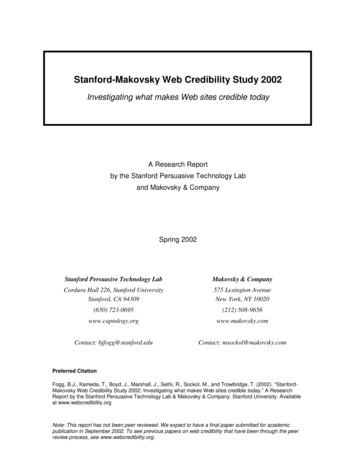
Transcription
Stanford-Makovsky Web Credibility Study 2002Investigating what makes Web sites credible todayA Research Reportby the Stanford Persuasive Technology Laband Makovsky & CompanySpring 2002Stanford Persuasive Technology LabMakovsky & CompanyCordura Hall 226, Stanford UniversityStanford, CA 94309575 Lexington AvenueNew York, NY 10020(650) 723-0695(212) 508-9656www.captology.orgwww.makovsky.comContact: bjfogg@stanford.eduContact: msockol@makovsky.comPreferred CitationFogg, B.J., Kameda, T., Boyd, J., Marshall, J., Sethi, R., Sockol, M., and Trowbridge, T. (2002). “StanfordMakovsky Web Credibility Study 2002: Investigating what makes Web sites credible today.” A ResearchReport by the Stanford Persuasive Technology Lab & Makovsky & Company. Stanford University. Availableat www.webcredibility.orgNote: This report has not been peer reviewed. We expect to have a final paper submitted for academicpublication in September 2002. To see previous papers on web credibility that have been through the peerreview process, see www.webcredibility.org.
Stanford-Makovsky Web Credibility Study 2002IntroductionWhen it comes to credibility, the World Wide Web is unusual. For some purposes, the Web ishighly credible. After stock traders access information on the Web, they make decisions wherethousands, and sometimes millions, of dollars hang in the balance. It’s arguable that for thesestock traders the information they find on the Web is the most credible information available.However, the Web can also be the least credible source of information. Many pages on the Webreflect incompetence, and some are pure hoaxes1. Because few barriers stop people frompublishing on the Web, the online world contains deceptive coverage of current events, healthinformation that is factually incorrect, and ads that promise the impossible.Web users are becoming increasingly skeptical of the information and services offered online2.As a result, those who offer Web sites—from large companies to single-person operations—nowface increasing pressure to enhance the credibility of their sites.Because the Web is a relatively new medium for information and transactions, little quantitativeresearch exists about what leads people to believe—or not believe—what they find online. Toenhance Web site design and promote future research on Web credibility, we launched our lab’sresearch on Web credibility in 1998. As researchers, our hope was to create a broadunderstanding of what makes Web sites credible, as well as providing a foundation—both inmethod and content—for future quantitative investigations. As designers, our hope was toenhance the practice of designing for Web credibility, offering Web site creators concrete data fordesign decisions they make on a daily basis.This document is a preliminary report of our latest effort in understanding Web credibility, aproject we did in collaboration with Makovsky & Company, a New York-based public relationsagency.webcredibility.orgPage 2
Stanford-Makovsky Web Credibility Study 2002What is credibility?(from Fogg & Tseng, 19993)What is “credibility”? Simply put, credibility can be defined as believability. Credible people arebelievable people; credible information is believable information. In fact, some languages use thesame word for these two English terms. Throughout our research we have found that believabilityis a good synonym for credibility in virtually all cases. The academic literature on credibility, which4dates back to the 1930s , presents a more sophisticated view of credibility, although the essentialmeaning is similar to what we propose. Virtually all credibility scholars describe credibility as—- a perceived quality5- made up of multiple dimensionsFirst, credibility is a perceived quality; it doesn’t reside in an object, a person, or a piece ofinformation. Therefore, in discussing the credibility of a computer product, one is alwaysdiscussing the perception of credibility.Next, scholars agree credibility perceptions result from evaluating multiple dimensionssimultaneously. Although the literature varies on how many dimensions contribute to credibilityevaluations, the vast majority of researchers identify two key components of credibility:- trustworthiness- expertiseWhat this means is that in evaluating credibility, a person makes an assessment of bothtrustworthiness and expertise to arrive at an overall credibility assessment.Trustworthiness, a key element in the credibility calculus, is defined by the terms wellintentioned, truthful, unbiased, and so on. The trustworthiness dimension of credibility capturesthe perceived goodness or morality of the source. Rhetoricians in ancient Greece used the termsethos to describe this concept.Expertise, the other dimension of credibility, is defined by terms such as knowledgeable,experienced, competent, and so on. The expertise dimension of credibility captures the perceivedknowledge and skill of the source.Taken together, these ideas suggest that highly credible computer products will be perceived tohave high levels of both trustworthiness and expertise.webcredibility.orgPage 3
Stanford-Makovsky Web Credibility Study 2002Why Does Web Credibility Matter?The success of most Web sites hinges on credibility. Those who create Web pages hope peoplewill adopt specific behaviors, such as the following: register personal information purchase things online fill out surveys click on ads contribute content to a community download software bookmark the site and return oftenIf Web designers can influence people to perform these actions, they have been successful. Whenpeople believe the information on a Web site, the site is more likely to achieve its goal. However,Web site designers will probably fail to reach their goals if people doubt the information, or ifthey find the Web experience to be deceptive (lacking trustworthiness) or amateurish (lackingexpertise). When a site lacks credibility, users are unlikely to remain on the site for long. Theywon’t buy things, they won’t register, and they won’t return. They certainly won’t think favorablyof the organization that sponsors the site.Although designing for Web credibility is one of the most important issues for Web sites, asearch reveals little public information on this topic and very little empirical research. To be sure,many have researched and shared views on Web usability, navigation, security, and so on; allthese play a role in credibility. But few have focused on helping Web site creators design forcredibility.The Purpose of this StudyOur purpose in the Stanford-Makovsky Web Credibility Study 2002 was to examine how a broadrange of factors affects people’s perception of Web credibility. In other words, we wanted to casta wide net in understanding what features of Web sites lead people to believe what they findonline. An accompanying goal was to replicate in part the study the Stanford PersuasiveTechnology Lab conducted in December of 1999 in order to confirm our research method andtake a current snapshot of how people respond to Web credibility6.webcredibility.orgPage 4
Stanford-Makovsky Web Credibility Study 2002What this Report CoversThis document reports on the findings from the latest large-scale study, the Stanford-MakovskyWeb Credibility Study 2002. We report the major findings, taken from the mean responses foreach item. Although we have not yet performed more sophisticated analyses on the data set, wehope the findings we report here will be notable and interesting.Research MethodThe QuestionnaireThe data for this study was collected through an online questionnaire7. Using this self-reportmethod allowed us to accumulate users’ perceptions on a wide range of Web site characteristics.The questionnaire consisted of 55 items that each related to an aspect of Web credibility (e.g.,“the site has a typographical error”, “the site is rarely updated with new content”). The majorityof the credibility items were taken from our first large scale study on Web credibility that ran in1999. The credibility items were selected though an extensive, iterative process, a methoddescribed in our previous publications8. Given that the Web is a dynamic medium, some changeswere necessary for this new study. Several original survey questions were discarded, some werereworded, and others were added to account for the shifting landscape of Web use andtechnology.Participants rated the credibility items on a 7-point Likert-type scale. For each credibility item,participants indicated whether the Web site element would make a Web site more or lessbelievable, selecting from the range "-3" ("Much less believable") to " 3" ("Much morebelievable"). Each participant was asked to answer the questions based on his or her cumulativeexperience using the Web. Consistent with our online research methodology, the order of thequestions was randomized for each participant to avoid an ordering effect.webcredibility.orgPage 5
Stanford-Makovsky Web Credibility Study 2002Figure 1: A sample of our online questionnaire, showing the format.Recruiting Study ParticipantsIn planning previous studies of this nature, we have acknowledged that recruiting a representativesample of all Web users throughout the world is extremely difficult, if not impossible. As a result,to include a wide range of people for this research, we recruited study participants in two ways:through the cooperation of charitable groups and through a news media organization in Finland.In addition to increasing diversity, the range of participants allow for a cross-cultural analysis ofthe data.United States participants were recruited through charity groups and Makovsky & Company, ourcollaborators in this study. Charity groups (such as the American Brain Tumor Association)received a donation of 5 for every person who completed the study on their behalf, up to amaximum donation of 3000. Other United States participants were drawn from onlinesolicitation conducted by Makovsky & Company.The rest of the participants were drawn from Finland. European participants came to the study byfollowing a link provided on the Alma Media Web site, a Finnish news media organization thathad collaborated with us in the 1999 study and continues to support this research.webcredibility.orgPage 6
Stanford-Makovsky Web Credibility Study 2002Running the StudyThe main part of the study ran during the winter of 2002. Participants went tohttp://www.webresearch.org at their convenience to take the questionnaire. Once the number ofparticipants neared 1500, we stopped data collection and began the analysis.Overall DemographicsWho participated in this study? Table 1 shows the overall demographic information for the 1481participants. The median age was 32 years old. The sample was 44.8% female, and 33.1% of thesample was from the United States. The participants had extensive experience with the Web;most had more than 5 years of Web experience, spent 10 hours online every week, and had mademore than 5 purchases online.Table 1: Summary of Participants’ Demographic InformationDemographic itemOverallAge (median)32 years oldGender44.8% female, 55.2% maleCountry33.1% U.S., 57.1% Finland, 9.8%from elsewhereEducation level (median)College graduateAnnual Income (median) 40,000 – 59,999Years on the Internet (median)More than 5 yearsAverage number of hours spentonline a week (median)10 hours/weekAverage number of purchasesonline (median)More than 5 purchasesResults & DiscussionFor the first part of our data analysis, we took the responses from 1481 people and calculated themeans for each of the 55 items in the study. Figure 2 shows the results for each item placed alonga continuum of Web credibility. Toward the top are items that boost credibility the most (highestmean is 2.0); toward the bottom are items that decrease credibility the most (lowest mean is –1.9). (Note: In Figure 2 the means have been rounded to the nearest tenth.)webcredibility.orgPage 7
Stanford-Makovsky Web Credibility Study 2002Figure 2: This figure shows the means for each item in the study, arranged along a continuum.The items are worded exactly as they were in the study.webcredibility.orgPage 8
Stanford-Makovsky Web Credibility Study 2002Presentation and Discussion of Overall ResultsThere are many ways to examine and interpret the data from this study. In this document we placethe individual items – the specific questions asked in the survey – into one of four categories:expertise, trustworthiness, ads, and other. While categorizing the data in this way has limitations,it succeeds in showing some general trends in the data. A factor analysis, as we have done withprevious data, may provide a different grouping of the individual items.Table 2: Expertise FactorsExpertise Factors that Affect Web CredibilityMeanThe site provides a quick response to your customer service questions.1.83The site provides comprehensive information that is attributed to a specific source.1.45The site lists authors' credentials for each article.1.31The site has articles that list citations and references1.30The site has search capabilities.1.18The site offers information in more than one language.0.98The site contains user opinions and reviews.0.77The site has ratings or reviews of its content.0.72The site selects content according to your preferences.0.57The site recognizes that you have been there before.0.39The site displays an award it has won.0.31The site provides comprehensive information that is unattributed to any source.-0.53The site has a typographical error.-1.26The site is sometimes unexpectedly unavailable.-1.29The site has a link that doesn't work.-1.42Table 2 shows that eleven out of fifteen expertise factors increase the perceptions of credibility.Sites were reported to be most credible when they were responsive in providing customer service(mean -1.83), making it clear that credibility can be enhanced from the operational backend.Sites were rated as more credible when they had standards for their content—such as when theyattributed content to specific sources, listed the credentials of authors, and provided references(means 1.45, 1.31, 1.30). Web operators—particularly content providers like magazines andjournals—could take advantage of these factors by implementing strict content guides for theirsites.webcredibility.orgPage 9
Stanford-Makovsky Web Credibility Study 2002Sites with extra features, such as search capabilities and multilingual support, were also givenpositive ratings of credibility (means 1.18, 0.98). Reviews and user opinions were fairlyimportant to users for credibility, with means of 0.77 and 0.72. The least dramatic increase incredibility came from a type of personalization: sites recognizing when a user had been therebefore (mean 0.39).Our data show that sites which failed to meet some of these standards would receive negativeratings on credibility. For example, sites that did not attribute their content to any source werereported to lose credibility. Technical problems such as broken links, site downtime, ortypographical errors were rated the most negative on this scale, with a broken link receiving amean of –1.42.The next group of items is related to trustworthiness, one of the key elements that make upperceptions of credibility. Table 3 shows the items and the resulting means.Table 3: Trustworthiness FactorsTrustworthiness Factors that Affect Web CredibilityMeanThe site has proven useful to you before.2.02The site lists the organization's physical address.1.67The site gives a contact phone number.1.56The site gives a contact email address.1.47The site is linked to by a site you think is believable.1.26The site states its privacy policy.1.21The site links to outside materials and sources.1.17The site was recommended by a news media outlet, such as a newspaper, magazine,or email newsletter.1.14The site was recommended to you by a friend.1.03The site lists well-known corporate customers.0.67The site represents a nonprofit organization.0.66The URL for the site ends with ".org".0.25One notable finding in Table 3 is the significant impact of a site having been useful to someonebefore. This high value of 2.02—the highest recorded in the study—shows that previous positiveexperience with a Web site will cause a dramatic change in a process we call earned credibility.On the other end of the scale, a domain name that ends in “.org” caused little change inperceptions of credibility.webcredibility.orgPage 10
Stanford-Makovsky Web Credibility Study 2002Sites with clear connections to the real world fared best in credibility. For example, theavailability of a physical address, a contact phone number, and an email address were ratedhighly (means 1.67, 1.56, 1.47). Further down the scale, a site received nearly equal boosts incredibility when it was recommended by a news media outlet (mean 1.14) or by a friend (mean 1.03). (While statistically significant, the difference in these two values is not likely to bepractically significant.)As for privacy and credibility, the study finds that sites which state a privacy policy were reportedto be more credible (mean 1.21).Many of these items, from providing contact information to having a privacy policy, are undercontrol of those who operate or design Web sites. In contrast, some items are not under directcontrol of the site designer: having well-known corporate customers (mean 0.67) andrepresenting a nonprofit organization (mean 0.66).Five items are grouped into a category we call sponsorship – issues relating to ads andadvertising.Table 4: Sponsorship FactorsSponsorship Factors that Affect Web CredibilityMeanThe site is advertised on the radio, billboards, or other media.0.77The site has ads that match the topic you are reading about.0.22The site has one or more ads on each page.-0.60The site automatically pops up new windows with ads.-1.64The site makes it hard to distinguish ads from content.-1.90Sponsorship provides an interesting lens through which to view Web credibility. Sites that wereadvertised on the radio or other media were reported to get a moderate credibility boost (mean 0.77). Asking about advertising from a different angle, our study found that the credibility gainedby using targeted online ads was nearly negligible (mean 0.22).For the most part, our respondents reported that advertising damaged a site’s credibility. Simplyhaving an ad on the site led to a slight decrease in credibility (mean -0.60), while pop-up adswere regarded even more harshly, seriously damaging the perceived credibility of the site (mean -1.64). Finally, sites that made it difficult to distinguish between ads and content were reportedto be the least credible of all; the mean here of -1.90 was the most negative score in this study.webcredibility.orgPage 11
Stanford-Makovsky Web Credibility Study 2002Table 5: Other FactorsOther Factors that Affect Web CredibilityMeanThe site is by an organization that is well respected.1.97The site has been updated since your last visit.1.65The site looks professionally designed.1.54The site is arranged in a way that makes sense to you.1.46The site's design is appropriate to its subject matter.1.21The site sends emails confirming transactions you make.1.20The site provides printer-friendly pages.0.99The site provides live chat with a company representative.0.62The site appeared on the first page of search engine results.0.60The site was the first site listed by a search engine.0.51The site is designed for e-commerce transactions.0.20The site contains content that differs from your opinions.0.11The site requires you to register or log in.-0.14The site has a commercial purpose.-0.28The site is hosted by a third party (e.g. AOL, Geocities).-0.43The site requires a paid subscription to gain access.-0.88The site takes a long time to download.-1.00The site's domain name does not match the company's name.-1.07The site represents a company that is having financial or legal difficulties.-1.08The site links to a site you think is not credible.-1.38The site is difficult to navigate.-1.38The site is rarely updated with new content.-1.65webcredibility.orgPage 12
Stanford-Makovsky Web Credibility Study 2002Table 5 shows how other factors affect Web credibility, both positively and negatively. Here wereport on a few of these items in no particular order, even though many findings in this othercategory are notable.The data show that Web credibility can be earned by an organization that is respected offline(mean 1.97). Next, it appears that one of the surest ways to create a credible site is to arrangethe site in a way that makes sense to the users (mean 1.46), and one of the surest ways to losecredibility is to make it difficult to navigate (mean -1.38). Furthermore, sites that are updated“since your last visit” are reported to be more credible (mean 1.65), while sites that are “rarelyupdated with new content” received the exact negative score (mean -1.65)Interestingly enough, sites requiring paid subscriptions to access content did not gain incredibility—they lost credibility (mean –0.88).Finally, the recent proliferation of dot-com financial troubles might have contributed to onefinding: sites representing a “company with legal or financial difficulties” were viewed to havelow credibility (mean -1.08).Table 5 lists other factors that significantly impact credibility.Design ImplicationsLooking at the findings in this study as a whole, we have compiled six overall designimplications, each of which will help boost a Web site’s credibility. We present these designimplications as a summary of the data reported in this document.Design Implication #1Add value to each Web visitIn general, our data suggest that sites gain credibility when they are able to recognize the needs oftheir audiences and provide tools or content to meet those needs. People who found Web sitesuseful in the past were likely to assign high levels of believability. Many of the highest-rankingstatements in terms of credibility cited features that improved a person's Web experience, such asfresh content, quick responses to customer questions, email confirmations of online transactions,search capabilities, printer-friendly pages, and contact information (either by phone, mail oremail).Design Implication #2Guard the integrity of your contentIn general, our data suggests that integrity of content has considerable impact on how peopleevaluate the credibility of a Web site. Study participants gave some of their lowest scores onwebcredibility.orgPage 13
Stanford-Makovsky Web Credibility Study 2002credibility to sites that fail to separate advertising from editorial content, run too many ads on apage, or display ads through pop-up windows. At the same time, users gave strong marks to sitecontent that identified its sources and provided its authors' credentials.Design Implication #3Make it simple to get aroundOur findings show that the quality of a site's navigational system can directly impact perceptionsof credibility. While the statement "the site is difficult to navigate" was reported to hurtcredibility considerably, its polar opposite ("The site is arranged in a way that makes sense toyou") was reported to be among the biggest contributors to credibility. The implication of theseand other results is clear: Web sites need to be easy to use.Design Implication #4Appearances matterBeautiful graphic design will not salvage a poorly functioning Web site. Yet, the study shows aclear link between solid design and site credibility. Participants said they were more likely tobelieve Web sites that looked professionally designed and appeared visually appropriate to thesubject matter. It’s clear from the data that Web users do not overlook simple cosmetic mistakes,such as spelling or grammatical errors. In fact, the findings suggested that typographical errorshave roughly the same negative impact on a Web site's credibility as a company's legal orfinancial troubles.Other appearance issues matter as well. Web users have expectations about a company's domainname. Companies that fail to include their name in their Web site's URL impact perceptions ofbelievability. Third-party hosting addresses (such as those found through AOL or Geocities) arealso detrimental to a Web site's credibility.Design Implication #5Make sure everything worksSimple technical errors can have the same devastating impact on credibility as poor design ornavigation. Broken links and unexpected downtime received some of the lowest marks on oursurvey. Site developers should also remain sensitive to the wide variance in access speedsthroughout the globe. Because slow download times impact site credibility, Web sites with simpledesigns may have a credibility advantage over Web sites that rely heavily on graphically richelements, such as animations.Design Implication #6Watch your reputation and your affiliationsAn organization's standing in the real world impacts the credibility of its institutional Web site.Not surprisingly, the results say that "well respected" companies also enjoy high levels of onlinecredibility, while companies with legal or financial troubles garner low rankings. At the sametime, the study indicates that Web credibility can also be positively or negatively affected bywebcredibility.orgPage 14
Stanford-Makovsky Web Credibility Study 2002outside associations. A credible site can bestow credibility on another site by linking to it, whilelinks to non-credible sites poisons the originating site's own reputation.These design implications represent our overall interpretation of the data at this stage. But ourgeneral interpretations may not apply to everyone. We encourage readers to examine each item inthe study and determine how the finding applies to their own situation.Some Next StepsThis study sheds new light on what factors affect the perception of Web credibility. However, aswe noted earlier, the findings presented in this document are an early step. While the mean scoresfor each item convey an overall picture, we intend to perform other analyses to generate newinsights. For example, a factor analysis of the data may show the underlying forces at work whenpeople evaluate the credibility of a Web site. In addition, analyzing people’s responses accordingto demographics will show how credibility evaluations differ according to education level,gender, country of origin, income level, and experience with using the Web. These are the typesof analyses we will soon undertake with this rich data set.Furthermore, we will take advantage of the opportunity to compare the findings from this 2002study with a similar study we performed in late 1999. This earlier study asked many of the samequestions to over 1400 people with nearly the same demographics. Putting the two data setstogether will allow us to compare how things have changed—or not changed—over time. Wemay be able to identify trends in how credibility is being evaluated and, perhaps, predict futuredevelopments in this area.AcknowledgementsThe Stanford Persuasive Technology Lab received help from various parties during this study.Makovsky & Company was our main collaborator, contributing time, expertise, and financialsupport. Also, we want to acknowledge the role of Alma Media in helping recruit participantsfrom Europe. We interacted with Alma Media purely via email, and their messages were alwaysfilled with humor and charm. Finally, we appreciate the role of the nonprofit organizations thattook an interest in this work, as well as the hundreds of people who found time to participate inthis study without compensation. These people and organizations made this study possible.webcredibility.orgPage 15
Stanford-Makovsky Web Credibility Study 2002Endnotes1You can find a few dozen examples of web site hoaxes at http://www.museumofhoaxes.com.2The most recent study to show that people are skeptical of what they find on the web is a study byConsumer WebWatch, part of Consumers Union (disclosure: BJ Fogg is an adviser to this organization).The study can be found at http://www.consumerwebwatch.org/news/1 TOC.htm.3The section defining credibility is taken from:Fogg, B.J., & Tseng, H. (1999). The Elements of Computer Credibility. Proceedings of ACM CHI99 Conference on Human Factors in Computing Systems v.1, 80-87. New York: ACM /chi/302979/p80-fogg/p80-fogg.pdf4For a review of credibility research, see:Self, C.S. (1996). Credibility. In M. Salwen & D. Stacks (Eds.), An Integrated Approach toCommunication Theory and Research. Mahway, NJ: Erlbaum.5For discussions about how credibility is made up of muliple dimensions, see the following:Gatignon, H., & Robertson, T.S. (1991). Innovative Decision Processes. T.S. Robertson & H.H.Kassarjian (Eds.), Handbook of Consumer Behavior. Englewood Cliffs, NJ: Prentice-Hall.Petty, R. and Cacioppo, J. (1981). Attitudes and Persuasion: Classic and contemporaryapproaches. Dubuque, IA: Brown.Self, C.S. (1996). Credibility. In M. Salwen & D. Stacks (Eds.), An Integrated Approach toCommunication Theory and Research. Mahway, NJ: Erlbaum.Stiff, J. (1994). Persuasive Communication. New York: Guilford.6The reference for our 1999 study is:Fogg, B.J., Marshall, J., Laraki, O., Osipovich, A., Varma, C., Fang, N., Paul, J., Rangnekar, A.,Shon, J., Swani, P., & Treinen, M. (2001). What Makes A Web Site Credible? A Report on aLarge Quantitative Study. Proceedings of ACM CHI 2001 Conference on Human Factors inComputing Systems. New York: ACM /chi/365024/p61-fogg/p61-fogg.pdf7Each research method has its own set of weaknesses, including surveys. Surveys don’t always capturehow people actually feel or behave. However, we chose the survey method because it was the mostefficient means of gathering a significant amount of data to build a foundation for future resea
Credible people are believable people; credible information is believable information. In fact, some languages use the same word for these two English terms. Throughout our research we have found that believability is a good synonym for credibility in virtually all cases. The academic literature on credibility, which
